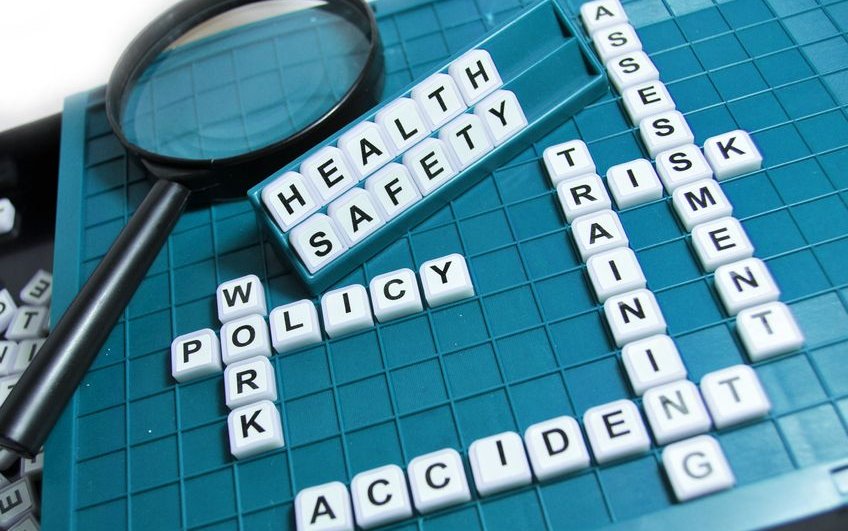If you employ five or more people, it is a legal requirement to have a written Health & Safety Policy detailing your organisation's approach to managing health and safety.

A clear and robust Health & Safety Policy is the backbone to strong safety performance and compliance. It establishes your approach to health and safety matters, affirms your commitment to preventing harm, and helps to promote safe working practices. It also provides useful direction for managers and staff and serves to get everyone within your organisation working towards the same goal of a healthy and accident-free workplace.
But what should a good Health & Safety Policy include?
Well, the Health and Safety at Work etc Act (HSWA) 1974 says that a Health & Safety Policy should contain three separate parts:
- A 'Health and Safety Policy Statement of Intent' (your aims and objectives);
- The organisation of health and safety (who has responsibility for what); and
- Your arrangements for health and safety (how risks are managed).
Let us do the hard work for you
Not confident in your ability to create a robust Health & Safety Policy, or simply don’t have the time? Our highly-qualified Health & Safety Consultants can create this essential document for you and tailor the contents to your organisation.
Let’s take a look at each of these sections in a little more depth.
Section 1: Health & Safety Policy Statement of Intent
This first part of a company’s Health & Safety Policy is the employer’s Health & Safety Policy Statement (sometimes referred to as the Statement of Intent). This sets out how your organisation intends to manage health and safety issues and meet health and safety requirements. The Health & Safety Policy Statement should contain your organisation’s safety aims (which are not measurable) and objectives (which are measurable).
Organisations with different workplace locations find it easier to express their management philosophy in an overall statement. A more detailed Statement of Intent and Health & Safety Policy can then be written and issued at local level.
When writing your statement, use clear and simple language so that your intentions can be easily understood. The statement itself is an expression of your commitment to managing health and safety across your organisation. As such, it doesn’t need to contain a lot of detail and can be fairly brief. It may be broken down using bullet points or a series of smaller statements. Two or three paragraphs may be enough.
Unfortunately, Health & Safety Policy Statements that make vague, sweeping promises and pledge to achieve the impossible (such as “We will use every means possible to prevent accidents”) can still be found. Instead, your employer’s statement should make specific, realistic commitments, including to:
Identify the principal hazards to employees and others affected by your work, and control the associated risks adequately.
Meet the basic requirements of the Health and Safety at Work etc Act – namely to maintain, so far as is "reasonably practicable", healthy and safe working conditions. For example, ensuring a safe plant, safe access and egress, safe equipment, safe systems of work, etc.
Meet the additional health and safety requirements of the Management of Health and Safety at Work Regulations (MHSWR) 1999, including conducting risk assessments, developing emergency procedures and providing health surveillance.
Make sure that employees have the necessary competency to carry out the tasks expected of them and provide appropriate and adequate health and safety training.
Consult employees on health and safety issues, possibly using a safety committee, and provide them with the necessary information, training and supervision to carry out their role without putting themselves or others at risk.
Regularly review – and, if required, revise – your Health & Safety Policy.
Meet specific immediate and long-term health and safety performance targets.
Have the resources to achieve the objectives outlined in the Health & Safety Policy Statement.
Setting health and safety performance targets
Health and safety performance targets are an important part of the Health & Safety Policy Statement as they indicate management’s commitment to continually improving health and safety performance, as well as motivate staff to achieve set goals.
The type of health and safety targets chosen will very much depend on the areas which need improving most in your organisation.
Common health and safety aims include:
- A specific reduction in the number of accidents, incidents and cases of work-related ill health;
- A reduction in sickness absences;
- A specific increase in the number of health and safety trained employees;
- Increased reporting of minor accidents and near misses;
- A reduction in civil claims;
- No enforcement notices;
- Achieving recognised health and safety standards and accreditations such as OHSAS 18001 or a RoSPA award.
In order to demonstrate managerial commitment to health and safety, the statement should be signed by your organisation’s most senior person – normally the Chief Executive Officer or Managing Director. This will show where ultimate responsibility lies.
Who’s responsible?
Under the Health and Safety at Work etc Act 1974, responsibility for ensuring the Health & Safety Policy is communicated to all employees rests with the organisation’s most senior person. The Health & Safety Policy Statement should detail how the policy is to be communicated.
Your policy should have been signed within the last 12 months. In other words, you should review your policy at least annually, noting within the policy the date it was last revised.

Not sure how to go about reviewing and updating your policy? A health and safety specialist can help to ensure it remains fit for purpose and enables you to meet your health and safety requirements effectively.
Section 2: Organisation of health and safety
This second part of your Health & Safety Policy document should set out the names, positions and duties of those within your organisation who have specific responsibility for health and safety. This is most often done with an organisational chart that shows the hierarchy of seniority within your organisation and identifies named persons’ roles in health and safety. As well as directors, managers and supervisors, this will include specialists such as safety advisers or works engineers, etc.
In small organisations, with very few management or control levels, a simple list may be enough.
In defining each person’s health and safety duties, the organisational structure must not contain overlaps or have the chains of command blurred. Each individual must be clear about their responsibilities and the limits of those responsibilities. Don’t get too job specific; you only want to outline the responsibilities relating to managing health and safety.
Furthermore, your employees should also have a precise summary of their duties, namely to take reasonable care of their own and others’ health and safety at work (particularly those defined in the MHSWR).
Non-compliance with the managerial duties detailed in your organisation’s Health & Safety Policy may be seen by the courts as amounting to negligence by managers/supervisors. Similarly, employees’ duties set out in the policy will define what amounts to taking “reasonable care” of themselves and others. Duties laid out in the policy may include summaries of regulatory health and safety requirements as well as your own health and safety rules.
Section 3: Arrangements for health and safety
The final part of your policy identifies the arrangements you have in place to manage and control the risks to the health and safety of people carrying out your activities or who might be affected by them.
Here, you should give details of the specific systems and procedures used to implement your Health & Safety Policy Statement. This will include details of first aid and washroom facilities, as well as your health and safety rules and procedures, including your procedure for reporting health and safety issues.
Health and safety risk assessments (including COSHH, PPE and manual handling) are commonly included within the arrangements section, particularly for hazards referred to in the Health & Safety Policy Statement. Arrangements for fire and other emergencies, as well as your arrangements for ensuring staff are provided with information, instruction, training and supervision, should also be included.
The arrangements part is likely to be the largest section of your Health & Safety Policy, and opinion varies as to the level of detail this final part should contain. Importantly, your policy is not supposed to be a long-winded or complicated document; it should simply reflect what you do and how you manage risk in line with all relevant health and safety requirements. Remember, you want everyone to quickly understand what you are trying to achieve.
What to include in your Health & Safety Policy
The contents of your policy will depend on the type of work you undertake. Depending on the nature of your business and the risks involved, you may need to include information on:
Employee health and safety Codes of Practice
Arrangements for reporting health and safety issues (accident and illness reporting, investigation procedures, etc.)
Emergency/fire drill procedures
Risk assessment procedures
First aid procedures
Control of exposure to specific hazards (noise, vibration, manual handling, hazardous substances, etc.)
Machinery safety
Maintenance and PAT testing of electrical equipment
Monitoring procedures, including health and safety inspections
Procedures for ensuring the safety of contractors, visitors and members of the public
Provision of welfare facilities
Health and safety training and induction procedures
Catering and food hygiene procedures
Arrangements for consulting with employees
Your health and safety policies and procedures for occupational driving
Your smoking, drugs and alcohol policy
Depending on the size of your organisation, this list can become quite lengthy, and you may need to add to it over time. As such, ensuring your policy remains effective isn’t always an easy task. Hands-on help from a named consultant will ensure your arrangements are not only robust but remain up to date year on year.
You should provide information about how particular arrangements are managed. Each arrangement should have its own heading. For example, under the heading “PAT testing”, you should outline:
- What you do to manage the risks associated with using electrical equipment; and
- Who or which position within your organisation is responsible for making sure PAT testing takes place.
Start offloading your health and safety pressures
Managing health and safety becoming a large undertaking? Not confident that you have everything in place to ensure legal requirements for health and safety are met?
At Ellis Whittam, we provide experienced, outsourced support to thousands of employers across the UK who, like you, want to know that their premises and practices are safe and compliant but lack the time or expertise required to do this in house.
Our unlimited, fixed-fee service gives you access to a named, highly-qualified Health & Safety Consultant for advice and guidance at any time, plus bespoke health and safety policies, downloadable health and safety templates, and on-site assistance with risk assessments to keep your business on the right track.






